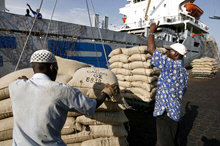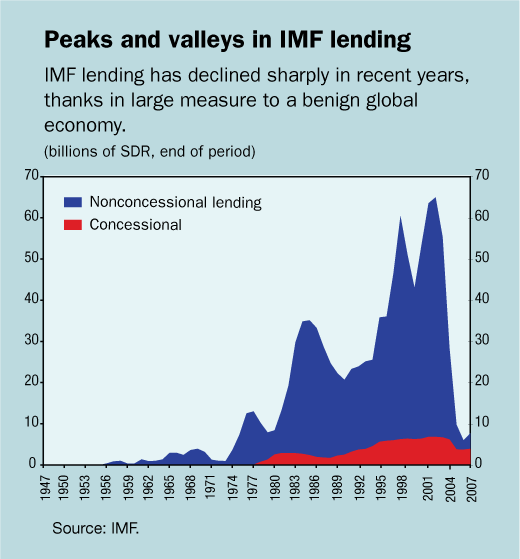
Typical street scene in Santa Ana, El Salvador. (Photo: iStock)
IMF Survey: IMF Launches Review of How It Provides Financial Assistance
October 9, 2008
- Global liquidity, growth mean little need for balance of payments financing
- More access to private capital markets changes low-income country needs
- New lending instruments designed to fill possible gaps in IMF tool kit
The IMF has launched a review of its financing role in member countries, to make sure it has the right instruments to meet countries' needs in a world characterized by growing—and increasingly complex—cross-border financial flows.

IMF economists have asked if definition of balance of payments need should be rethought in light of financial globalization (photo: Issouf Sanogo/AFP)
THE FUND'S FINANCING ROLE
The IMF's Executive Board had a first discussion of the institution's financing role on September 22, 2008. "Although the Fund has a record of adapting to change, the truth is that our lending instruments are based on a model that may no longer be suited to the needs of a large part of the membership," Managing Director Dominique Strauss-Kahn told IMF Executive Directors.
Declining demand for IMF resources
Demand for the IMF's general resources has dropped sharply in recent years, along with a more modest decline in the demand for loans provided under the IMF's loan programs for low-income countries (see chart). But economists are divided on whether this really is a problem.
Some see this as a sign of success. In recent years, ample global liquidity and strong growth has meant that there has been little need for balance of payments financing from the IMF. The Fund is still the best placed international institution to provide and coordinate financial packages in the event of a crisis, this argument goes.

Others are less sanguine, pointing to the fact that many members seem to shun the IMF and instead seek other solutions to their balance of payments needs. Examples include promoting regional reserve pooling and financing arrangements, building substantial international reserves, exploring loans and contingent financing from other international financial institutions, and relying on bilateral swap lines for foreign exchange liquidity. They argue that the Fund's financing instruments do not provide members with the services they need, come with too much conditionality, provide too little financing at a cost that is too high, and send negative signals to the public and markets alike (what is known as stigma).
Rationale for IMF lending today
Through its lending, the IMF continues to provide an important international public good: protecting balance of payments stability and an open system of international trade, and reducing the likelihood of crises spreading from one country to the other through financial contagion and spillovers from disorderly adjustments. The private sector and individual countries cannot be counted on to provide this public good.
A number of issues were discussed at the Board meeting.
What should trigger an IMF loan? Fund financing may only be committed on the basis of an actual or potential balance of payments need, but BOP crises may originate in domestic fiscal or banking disruption. IMF economists asked whether the very definition of a balance of payments need should be rethought in light of financial globalization.
What should be the role of conditionality? Most IMF lending is disbursed in tranches and is subject to conditionality to ensure that problems are resolved in a manner that is not destructive to national or international prosperity and to limit risks to the Fund. But as member countries strengthen their policies and gain better market access, their need for traditional phased support has declined, while their need for support to cope with potentially self-correcting shocks and maintain investor confidence has risen.
The paper floated three alternative approaches that could be considered instead of traditional loan conditionality in certain circumstances:
• Relying on selective qualification tests and monitoring only during reviews rather than the IMF's current policy of standard periodic test dates and performance criteria.
• Providing support in the form of outright loans rather than under tranched loan arrangements, based on a country's past record and current policies.
• Using collateral instead of conditionality; rethinking IMF lending instruments.
The paper identified a number of possible new lending programs, each designed to fill perceived gaps in the IMF's tool kit.
• A pure signaling instrument. The IMF could consider making the Policy Support Instrument (PSI) available to all its members, or creating a signaling instrument similar to the PSI for middle-income countries.
• A crisis-prevention instrument. The IMF has been considering for some time now the creation of a new liquidity instrument. One idea was tentatively called Rapid Access Line, or RAL. Separately, two IMF Executive Directors have proposed a Financial Stability line. These would be specifically designed to fortify countries' defenses against capital account crises. While there is broad agreement on important design features, progress on a new liquidity instrument has been delayed by various concerns, including on how to handle the "first mover" problem (countries worry that markets may misread a commitment to sign up for contingent support as a sign of impending trouble), and the fear of creating an instrument that goes unused.
• A short-term liquidity instrument. More advanced IMF member countries can experience periods of turbulence when they need short-term foreign exchange liquidity at short notice. These countries typically rely on foreign exchange swaps with other central banks. Until now, the IMF has eschewed any role in such transactions, but why should there not be a role for the Fund? It could establish a quick-disbursing short-term liquidity facility available to countries with very strong track record and policy frameworks.
• A "quiet" facility. Finally, could IMF financing be provided without a public announcement to that effect? While such a facility would run counter to the general move toward greater transparency in the IMF and among member countries, it would reduce the perceived stigma attached to IMF loans that might prevent countries from approaching the Fund for assistance.
IMF economists also floated the possibility of eliminating, or at least reforming, seldom-used loan programs, including the Supplemental Reserve Facility, the Compensatory Financing Facility, and the Extended Fund Facility.
Helping low-income countries
The Poverty Reduction and Growth (PRGF) framework is widely used and will remain central to the IMF's engagement with its low-income countries. These countries also receive support for their policies and a signal of their quality under the Policy Support Instrument (PSI), which does not involve actual lending. However, as more low-income countries gain access to private capital markets, there is likely to be a shift in their need toward short-term balance of payment support, policy advice, and signaling to markets.
In response to the global food and commodity price spike, the Executive Board decided on September 19 to modify the Exogenous Shocks Facility (ESF) to improve the IMF's ability to provide rapid assistance. But low-income countries are also confronted with short-term balance of payments needs that are home-grown. Since such financing needs would not be covered by the ESF, which is designed to address external shocks only, the Fund could consider a Stand-By Arrangement (SBA) for low-income countries. The SBA, which has been in place since 1952, has been the IMF's most widely used facility.
Next steps
"It is critical for the Fund to have a robust lending function that meets the needs of our members. Giving confidence to members by making the Fund's resources available to them, as enshrined in the Articles of Agreement, is and should be a fundamental purpose of the Fund," Strauss-Kahn said at the Board meeting. To fulfill this role, it has become clear that reform is needed.
Not all ideas discussed in the staff paper will be taken forward. The road map for the coming year will focus on five broad areas: developing an analytical framework for the IMF's lending; advancing work on a new crisis prevention instrument; reviewing access limits and financing terms for using Fund resources; re-examining the use of conditionality; and considering lending instruments for low-income members.
Comments on this article should be sent to imfsurvey@imf.org







